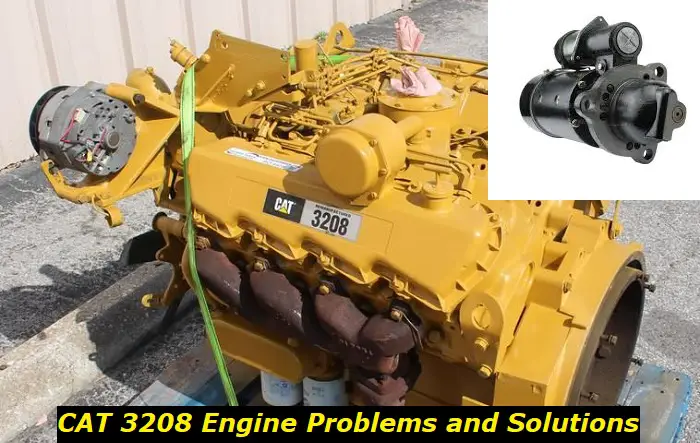Common Problems with CAT 3208 Marine Engines Explained
Caterpillar is known for manufacturing some of the best engines in the world. For anyone looking for a reliable marine engine, the CAT 3208 is one of the best options in the market. The engine started being made in 1975, and for two decades, it had one of the best runs in the CAT diesel engine industry. But like every engine in the market, the 3208 had its issues.

In this article, we look at the CAT 3208 marine engine. We take an in-depth look into the specs and the features of the engine and how it works. To get a better understanding of the engine, we will look at the various issues you might encounter as an operator of the CAT 3208 marine engine. After reading this article, you will be well-versed with the specs of the different 3208 variants and how you can deal with the common problems that hamper its performance. As a potential buyer of a marine engine, you will be well-equipped with information that will help you make the best decision.
The CAT 3208 marine engines
Since its introduction, the Caterpillar 3208 marine engine has been a favorite for many seafarers. The engine was designed to serve the different needs of a wide range of sea vessels. Among the engines you could pick to power your vessel include;
- CAT 3208 210HP
- CAT 3208 375HP
- CAT 3208 435HP
All the CAT 3208 marine engines have a V8 configuration, which makes it possible to displace 10.4 liters and produce that much power. It is worth noting that the CAT 3208 marine engine is different from that installed on trucks. The flywheel and the starter location are some of the differences. The exhaust manifolds and the turbo in the marine engine are coolant-cooled, unlike those of trucks that are cooled differently. CAT considered the tight engine room in the sea vessel, unlike in the trucks that have lots of space available.
The different CAT 3208 marine engines boast a bore diameter of 114.3 millimeters and a stroke of 127 millimeters. The compression ratio of the 210 and 375HP engines is 16.5:1, and that of 435HP is 15.5:1. While you may find cast iron camshafts on the older engines, a majority of CAT3208 have a forged steel camshaft. The oil system of the engine boasts a 12-15 liter capacity.
What are the common problems with CAT 3208 marine engines?
The CAT 3208 is a great marine engine. Even though you will find 3116, 3126, Detroit, and Cummins, there is a lot that 3208 has to offer that you can't ignore. Save for the very unlucky boaters, very few people can stand and condemn the 3208 engine for its unreliability. It has been powering trawlers, boats, and other sea vessels for thousands of hours.
Through aggregation from owner online boating and boating forums, we have managed to come up with a good list of what can be called common CAT 3208 marine engine problems. These issues have been reported by a diverse population of CAT 3208 owners over the years.
One thing to note, however, when it comes to analyzing 3208 problems is the age of the engine. CAT 3208 is pretty old in the industry, and CAT has since been launching other better and superior engines. This means that even though 3208 might be your best engine in the performance and reliability section, CAT, competition, and technology have since taken a step forward and given the marine industry better engines to power the millions of sea vessels in the waters. Moreover, in some cases, though not often, the parts for this engine can be rare. When looking at CAT 3208 marine problems, age is something to take into consideration.
1) White smoke problem
Some CAT 3208 owners have reported seeing white smoke coming out of their engines. White smoke is an indicator that coolant is leaking into the combustion chambers or exhaust system. Remember that the CAT 3208 has a coolant-cooled turbo. You can tell if the coolant is the source of the white smoke if the exhaust smells slightly sweet. There could be water in the fuel, or the quality of the fuel may be bad, causing the exhaust smoke to be white.
The problem can be a cracked head gasket if you are unlucky. A cracked head gasket will mean fuel can get contaminated with coolant, hence the white smoke. Another common cause of white smoke in 3208 is a cracked injector.
Solution
Depending on the root cause of the white smoke, there are different ways to solve this issue. If all you see is a puff of smoke when you start the engine, then there is nothing to worry about. This is because the fuel in the injectors is not hot enough, and this makes it impossible to burn all of it. So this smoke is due to unburnt fuel. This can be solved by putting a fuel additive to the fuel.
If you discover water in the fuel or if it's contaminated, the solution would be to drain the fuel and change the fuel filters. The water separator is a good place to start when you discover water in the fuel. The cost will be much more if the head gasket or the EGR is the cause of this white smoke problem. Further diagnostic should be done to establish the exact cause and to help you do a cost-benefit analysis.
A cracked injector tip has also been seen to cause excessive white exhaust smoke. The answer to this issue is to replace the injector. If the problem is water in the fuel system, use a fuel additive, change the filter, and ensure you only put good quality fuel. You should also know how to bleed the fuel system if you are to authoritatively solve a fuel-related problem.
2. Compression issues
The compression problem is, in some way, an extension of the white smoke issue. When you have a compression problem, you are likely going to notice white exhaust smoke. Another symptom that CAT 3208 operators have reported is poor fuel economy, misfires, rough idling, and problem starting.
Solution
The answer to a compression problem in your CAT 3208 requires that you know the compression ratio first. For the 435HP engine, the ratio is 15.5:1, while that of lower HP variants is 16.5:1. You will need to loosen a fuel line nut located at the fuel injection pump to find the cylinder with compression issues. This is done until you locate the loose fuel line that is making no difference in an engine running roughly.
This procedure is supposed to be done by a CAT expert who has knowledge of the removal and diagnosis of injector nozzle issues. The crankshaft should be rotated until the piston in the cylinder you are checking is at TC on the compression stroke. Force the air into the cylinder and check for any air leakage. This test should tell you whether the leakage is into the crankcase, the piston, or the inlet valve.
3) No liners
The CAT 3208 engine runs perfectly well until it doesn't. But then every other engine has its design issues that make a whole group of buyers dislike it. In the case of the CAT 3208, the lack of cylinder liners is a big issue for those who are looking to install new pistons.
When the piston in a CAT 3208 engine seizes, then you will be in for some serious trouble. The procedure requires that you re-bore the engine block and fit it with larger liners. This means the pistons used will be larger, and this might change a few dynamics of the engine output and performance.
Solution
The procedure is not cheap, and in some instances, some owners prefer to just buy a new engine instead of going through all that expensive trouble. But then, it is not every day that a piston seizes, especially if proper engine maintenance is taken.
4) Higher RPM issues
Those who have not sampled a variety of 3208 engines might come to the conclusion that the engine is a terrible marine performer. This is especially the case if one has a 435HP engine. This engine has been seen time and again and among numerous boaters to be a bad pick, especially if you do high RPMs.
Solution
The first thing to note about the CAT 3208 engine is its rating; none is rated beyond 2,800 RPM. This being the case, and considering that many people have encountered issues at high RPMs, it would be prudent not to go beyond 2,800 RPM. Many CAT 3208 owners seem to agree that the 300HP range engine is the best pick.
5) Cracked cylinder head
Quite a number of CAT 3208 marine engine owners have come forward with a cracked cylinder head. This, to say the least, is a serious issue whose remedy is both expensive and cumbersome. A cracked head causes the engine to overheat, poor fuel economy, and exhaust, producing a lot of smoke.
Solution
The answer to a cracked cylinder head is simply to replace it. Replacing such a head requires a new head gasket and, in some cases, a whole set of piston ring kits. The labor involved is quite intense, and a lot of expertise is a must.
Conclusion
To own a CAT 3208 marine engine is something of a fete, given that this is one of the best marine engines in the industry. The engine has been proven to serve hundreds of thousands of hours. With proper maintenance, you will enjoy your engine for many years. Take note of the highlighted problems to help you solve and even avoid some common 3208 issues that might befall your marine engine.

Add comment